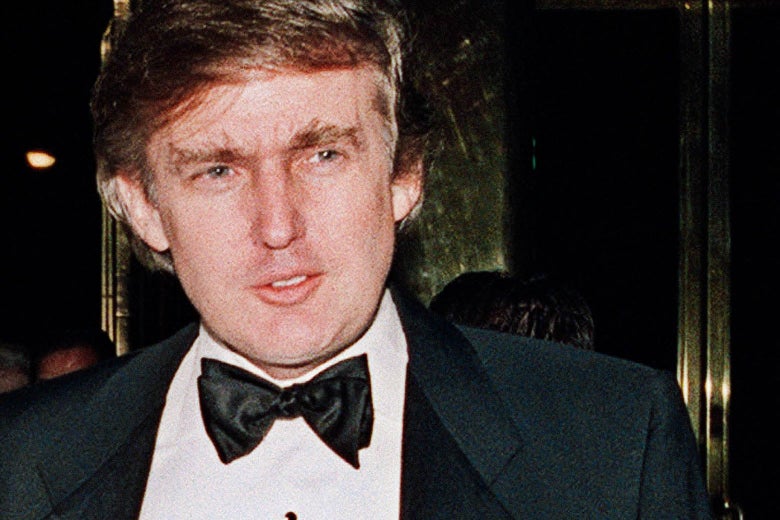
Donald Trump, pictured in New York on Dec. 4, 1989
Swerzey/AFP via Getty Images
When Rep. Jerry Nadler bangs his gavel Wednesday morning, not only will he open the House Judiciary Committee’s impeachment hearings against President Donald Trump—he will also reopen a feud between the two men that dates back 35 years.
The fight began in early 1985, when Trump, then an up-and-coming real estate tycoon, paid $115 million for an abandoned rail yard on Manhattan’s West Side and unveiled plans to turn its 76 acres into the largest development in all New York City: six 75-story high-rises holding 8,000 apartments and 10,000 parking spaces, a massive shopping mall, TV studios, and—looming above it all—a 150-story skyscraper, where he would live on the top floor, above the clouds. The complex would be called Television City.
Standing in the way of this gargantuan project was a group of neighborhood activists and celebrities. Nadler was their state assemblyman, and he led the protest against Television City—a role that he continued playing after he was elected to Congress in 1992. A crucial part of Trump’s plan involved relocating a stretch of the West Side Highway, which would otherwise obstruct views of the Hudson River. The move, estimated to cost more than $300 million, would require federal funding. From his new perch in Washington, Nadler did all he could to block the subsidy.
Trump fought back, railing at Nadler in the local media, especially in the two main tabloids, the New York Post and the Daily News, calling him “stupid,” “dumb,” and—just as he now lampoons his foes as “Sleepy Joe” or “Shifty Schiff”—“Fat Jerry.” (Nadler weighed more than 300 pounds at the time; he later slimmed down through surgery.)
In one sense, Trump should thank Nadler for helping to scuttle the grand project.
Nadler also lobbied then-President Bill Clinton’s secretary of housing and urban development, Andrew Cuomo, to reject Trump’s request for federal mortgage insurance, arguing that the project would contain no low-income units. (Trump still resents Cuomo, who is now in his third term as New York governor.) From City Hall, Mayor Ed Koch, who deeply distrusted Trump, offered NBC a tax break if it remained at midtown Manhattan’s Rockefeller Center instead of moving to New Jersey, as its executives were mulling—but he said he wouldn’t give it or any other media company a tax break if it moved to Trump’s planned TV studios. (As a result, Trump changed the name of the complex from “Television City” to “Trump City.”)
Facing protests on many fronts and unable to raise the necessary funds, Trump negotiated with the activists, the City Council, and even with Nadler, scaling down the project considerably—but not enough to satisfy them. Meanwhile, financial reports revealed that Trump’s other investments were hemorrhaging money. Facing reality, he sold the rail yard, on which he’d started constructing 20 buildings, to a group of Hong Kong businessmen.
It was quite a deal. They paid Trump $90 million in cash, assumed his debts (more than $250 million) and back taxes ($6 million), and let him retain 30 percent ownership of the much-reduced complex, which was now called Trump Place. He ultimately sold the property for more than $1 billion. (The Trump name remained embossed in gold letters, though since his election as president, the residents in a few of the buildings have removed them from the marquees.)
In one sense, Trump should thank Nadler for helping to scuttle the grand project. Had Trump proceeded, he almost certainly would have dug in deeper, lost a fortune, and possibly gone out of business for good. The Hong Kong deal saved him from personal bankruptcy (his businesses had gone bankrupt three times, but he’d never had to file for Chapter 11 personally) and gave him enough money to jump-start some new projects. More important, it polished his reputation as a deal-maker—which led to The Apprentice, which led to his presidency.
Nadler won the battle, but lost the war. He’d had his own plan for the property. He wanted to revive the rail line, extend it under the Hudson across into Brooklyn and from there to the rest of the country, restoring New York’s status as a locus of shipping—not through its once-thriving seaport, which New Jersey had long displaced, but through rail-freight. Nadler pushed this plan for many years but could never get funding from Port Authority, which is run by state officials in New York and New Jersey. Finally, his idea was snuffed out permanently by the High Line—the elevated park that stretches across the old rails and has emerged, since it opened in 2009, as one of the city’s liveliest, if least likely, tourist attractions.
Decades have passed since the fight with Nadler fizzled out, but Trump holds grudges forever. This past April, at a White House meeting with a group of House Republicans, the president started ranting about Nadler, who’s launching an investigation into possible malfeasances. Once again, as in days of yore, Trump railed against him as “Fat Jerry.”
Not long after, he tweeted that “Nadler fought me for years on a very large development I built on the West Side of Manhattan.” He went on, “[N]ow I am dealing with Congressman Nadler again. Some things never end, but hopefully it will all go well for everyone. Only time will tell!”
Readers like you make our work possible. Help us continue to provide the reporting, commentary and criticism you won’t find anywhere else.
Join Slate Plusfrom Slate Magazine https://ift.tt/2Rf5bOQ
via IFTTT
沒有留言:
張貼留言